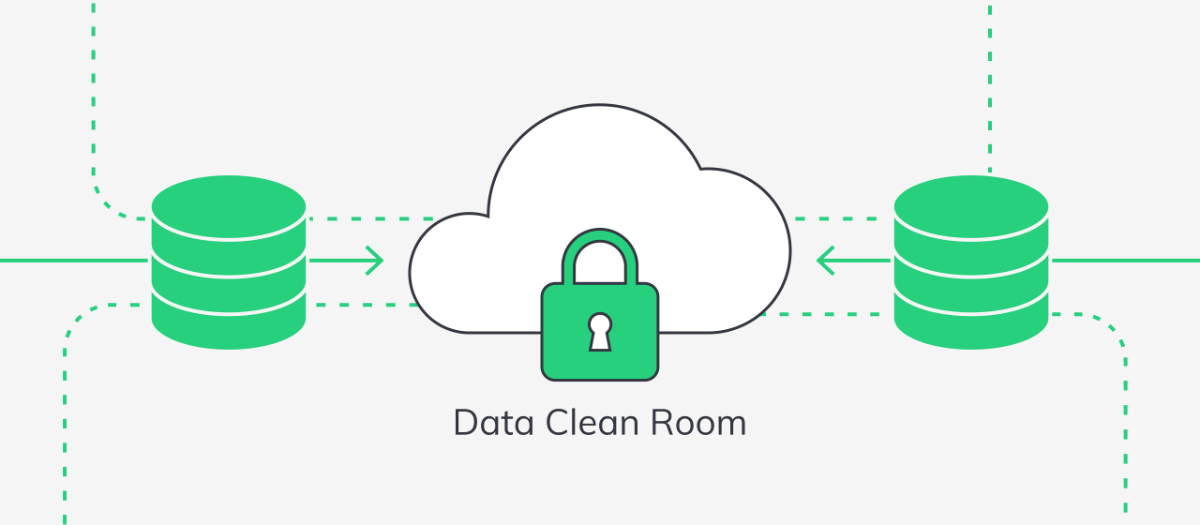A data clean room serves as a fortified digital haven where multiple entities can exchange user data and collaborate, all while upholding stringent privacy protocols.
Within this sanctuary, brands, media publishers, and advertisers can safely share first-party and other customer data, ensuring it remains protected and controlled. While data can be compared and analyzed for aggregated insights, raw data remains concealed, with personally identifiable information either stripped or obscured.
By fostering collaboration and facilitating the analysis of amalgamated data sets, data clean rooms empower brands to delve deeper into customer insights. Anonymous data is harmonized and enriched, equipping companies with actionable intelligence to craft targeted marketing campaigns and gauge their effectiveness.
Moreover, these sanctuaries aid companies in adhering to data privacy regulations like GDPR and CCPA, while also serving as a lifeline for marketers navigating Apple’s heightened iOS privacy measures and the impending demise of third-party cookies—a transition Google anticipates completing in the latter half of this year. 📊
According to a Deloitte Digital survey of 500 global executives across 11 industries, one out of three use data clean rooms extensively. Nine out of ten expected to ramp up their use of the technology.
How Does a DCR Work? 🤔
DCR technology typically follows a straightforward operational process, encompassing four key stages:
1. Data Loading 📥 – Companies upload their first-party data into the clean room.
2. Security and Privacy Controls 🔒 – Robust measures like encryption and anonymization are implemented to safeguard the data.
3. Connection 🔄 – Data sets are matched and organized into cohorts for analysis.
4. Application 📊 – Participating companies utilize the aggregated data for marketing research and campaigns.
The outcome? DCR participants gain access to a more comprehensive dataset, empowering them to conduct in-depth audience research and craft finely targeted marketing and advertising strategies. They can fine-tune their approaches, assess marketing performance, and operate more efficiently and effectively.
Throughout this process, contractual agreements are in place to ensure strict controls on data loading, usage, and application, with data privacy remaining the foremost concern. 🔐
🔍 Unlocking the Benefits of Data Clean Rooms 🛡️
Data Clean Room (DCR) technology is gaining momentum as companies seek to modernize their marketing strategies for a privacy-centric digital landscape.
According to an IAB survey, safeguarding data privacy is the primary use case for companies adopting DCR technology, particularly when sharing data with external entities.
This privacy-centric technology offers a plethora of advantages, including:
1. 🎯 Targeting with Collaborative Data Sets: DCRs enable targeting without relying on third-party cookies, which are becoming obsolete.
2. 🧠 Deeper Customer Insights: A survey of North American marketers by the CMO Council revealed that in-depth analytics are the foremost driver for implementing DCR strategies.
3. 📊 Enhanced Campaign Performance Measurement: DCRs facilitate improved measurement of campaign performance and effectiveness, as indicated by 5% of CMO survey respondents.
4. 🔒 Security and Privacy Compliance: DCRs help companies maintain compliance with evolving security and privacy regulations.
5. 🌐 Exploring New Market Opportunities: DCRs contain detailed advertising impression data without storing personally identifiable information, enabling marketers to identify new market opportunities without risking privacy violations, according to a Gartner report.
Navigating the Challenges of Data Clean Rooms
While data clean rooms offer substantial benefits, they also come with notable drawbacks. Primarily, they are not turnkey solutions; their implementation demands significant investments in terms of finances, time, and skilled personnel. This places smaller companies, lacking extensive resources, at a distinct disadvantage, as highlighted in the IAB report.
According to the survey, nearly two-thirds of respondents invested at least $250,000 in their DCR initiatives in 2022, with a quarter spending up to half a million. Additionally, almost half of DCR users allocate six or more employees to manage the technology, while 30% dedicate at least 11 personnel to it.
The setup process is intricate, involving the configuration of governance settings, data onboarding procedures, and establishing connections with multiple partners. Companies reported that it took months, with some indicating it took a couple of years, to fully operationalize the technology, as noted by IAB.
Other challenges include:
- Interoperability with existing technology
- Privacy regulations continue to evolve; controls must be constantly monitored for compliance
- Collaboration and agreement with partners on DCR tech and rules
🔮 The Future of Data Clean Rooms 🚀
Deloitte Digital analysts assert that Data Clean Rooms (DCRs) are swiftly becoming integral to the marketing and advertising strategies of major brands, opening avenues for innovative business models.
Gartner recommends that companies spending over $1 billion annually in advertising should invest in DCR technology immediately. For those with ad budgets below $100 million, Gartner suggests exploring DCRs as self-service solutions.
Despite the costs and hurdles, the market for DCRs is set to burgeon and evolve, alongside other privacy technologies. Marketers are actively seeking solutions to navigate the ever-changing landscape of privacy regulations, market trends, and customer preferences.
